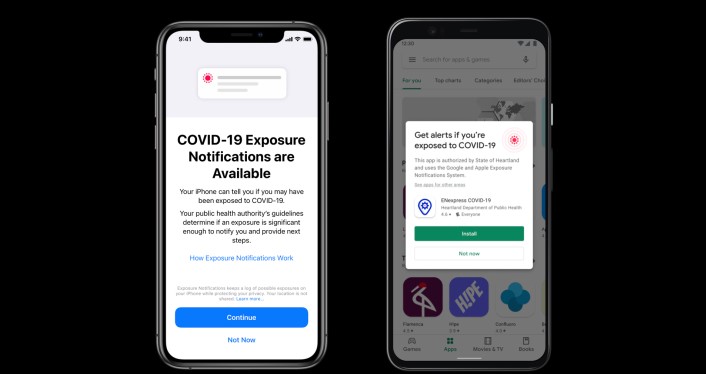More than 8.1 million individuals in the U.S. have transformed their iPhones and Android gadgets into pandemic contact-tracing tools, however it hasn’t been very useful when their neighbors, classmates and coworkers aren’t on a similar system.
Apple and Google co-made “exposure notification” technology to alert telephone clients in the event that they invested energy close to somebody who tests positive for the coronavirus, so they know to get tried, as well.
It’s worked with tight security limitations to keep up clients’ anonymity, however the tech companies have left it to each state’s general health authority to conclude whether to utilize it. Up until now, 16 U.S. states, in addition to Guam and Washington, D.C., and in excess of 30 nations have made the exposure notification system accessible to their inhabitants.
HOW Can IT WORK?
The innovation depends on Bluetooth short-range radio signs to identify when two telephones are in closeness for a considerable length of time for somebody to almost certainly communicate the infection. Most states measure that nearby contact as inside 6 feet for at any rate 15 minutes in a day.
Those wireless experiences — the sort that may occur between outsiders on a train or in a crowded store — are randomly created into keys and incidentally signed in a manner that doesn’t uncover an individual’s personality or geographic location.
At the point when one individual tests positive for the infection, and state health laborers confirm the analysis, other people who as of late invested energy close to the tainted individual get a programmed alert. That likewise accompanies counsel from your state wellbeing organization about how to get tried and try not to spread the infection.
WHERE AND HOW CAN YOU USE IT?
In Colorado, Connecticut, Maryland and Washington, just as Washington, D.C., iPhone clients don’t need to download an application, yet should change their telephone settings to agree to the following. Android clients in those spots must download an application that Google has naturally created for the area’s public health agency.
In another 13 spots, public health agencies have custom-built exposure notification applications that can be found in the Apple and Google Play application stores. Those spots are Alabama, Delaware, Guam, Michigan, Minnesota, Nevada, New Jersey, New York, North Carolina, North Dakota, Pennsylvania, Virginia and Wyoming.
Four different states have a restricted test case program: Arizona, California, Hawaii and Oregon.
WHAT IF YOU CROSS BORDERS?
On the off chance that you travel between the spots where the technology is initiated, as a rule it doesn’t make a difference that you’re utilizing your house state’s application. It actually tracks on the off chance that you’ve been exposed elsewhere.
That implies, for instance, New Jersey inhabitants who download their state’s application are as yet going to get signals from New York application clients on the off chance that they go through the day in Manhattan.
That is on the grounds that a gathering of organizing general wellbeing offices has set up a mutual public worker of Bluetooth keys. A comparative plan occurs over some public outskirts in the European Union.
ARE THERE GLITCHES?
Indeed, some as much attached to human conduct as innovation. Clients have grumbled about the cycle for confirming a case, which can differ by state however ordinarily depends on a discussion between the tainted individual and regularly overpowered human contact-tracing groups.
As an protection against prank alerts, no notifications are set off until the general health agency has checked that an application client has COVID-19. In certain states, somebody who tests positive and needs to educate others concerning it should initially get a code from a health worker. A few clients never get that code, or get it however never enter it into the application. In the midst of a furious pandemic, it’s not generally the principal thing at the forefront of everybody’s thoughts.
HOW MUCH PARTICIPATION MAKES IT EFFECTIVE?
Guam authorities said they were instructed to get 60% concerning the island region’s grown-up populace utilizing the application for it to be powerful, however it’s uncommon for even the most popular shopper applications to get that sort of reach.
Add the politicization of COVID-19 response in the U.S., the stigma of sickness, security fears and confusion over each state having an alternate methodology and it’s not amazing that eagerness has been deficient.
The 60% objective came from an Oxford University concentrate recently, however Oxford specialists later underscored that even far lower support rates can spare lives.
They assessed in September that, in the territory of Washington, a “well-staffed manual contact tracing workforce combined with 15% uptake of an exposure notification system could reduce infections by 15% and deaths by 11%.” Washington’s framework went live on Nov. 29 and inside a day had about 9% selection.
Participation has been most noteworthy in states where iPhone clients don’t need to download an application and get a pop-up prompt welcoming them to agree to the tracking.

Napier Boyd is an American author. He graduated from Occidental College, he later received an honorary Ph.D from Occidental College. Napier is known for his ten years as anchor and editor. Recently he is working on Boston New Times.
Disclaimer: The views, suggestions, and opinions expressed here are the sole responsibility of the experts. No Boston New Times journalist was involved in the writing and production of this article.
